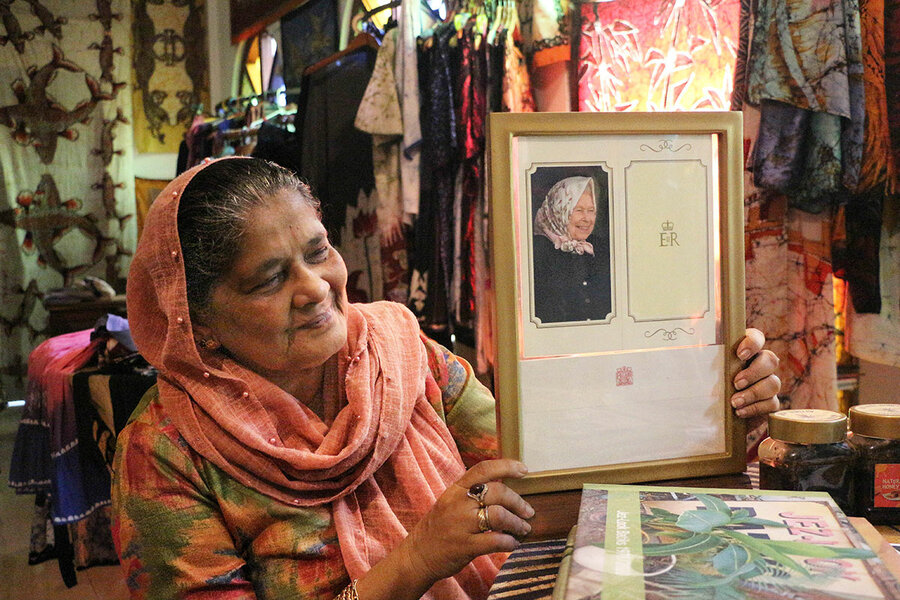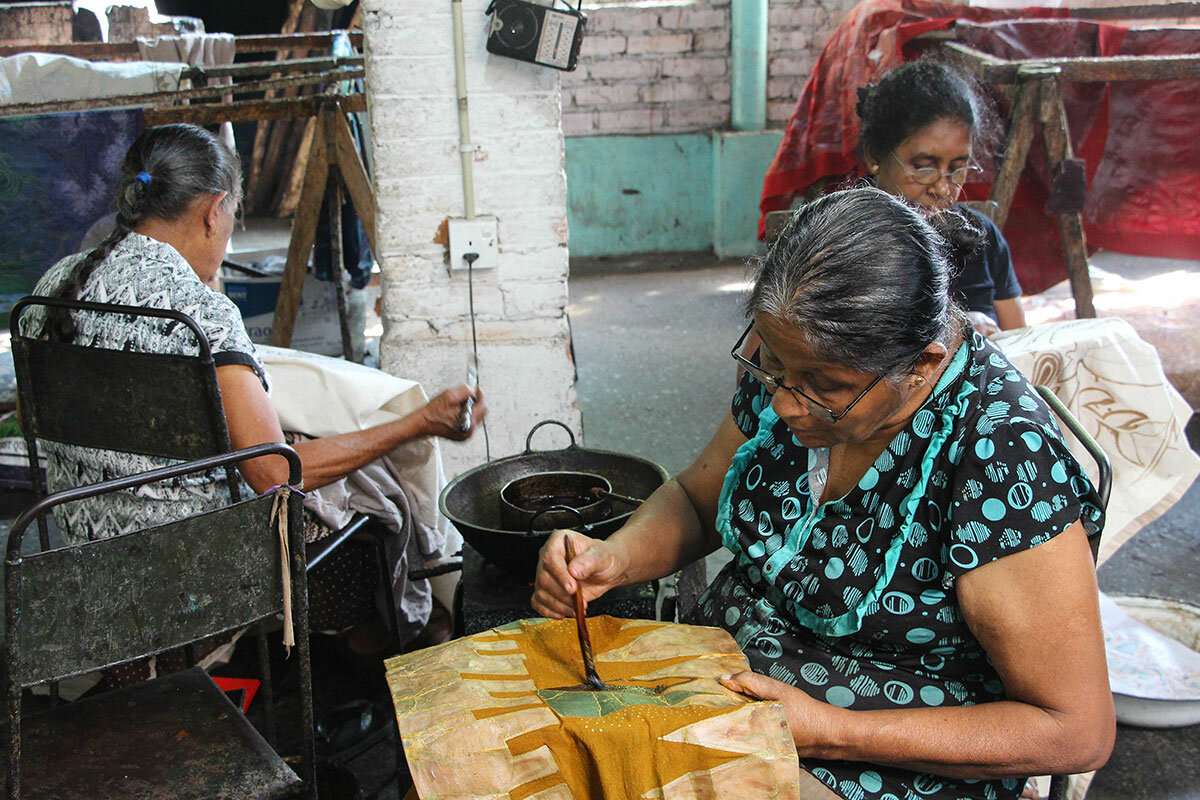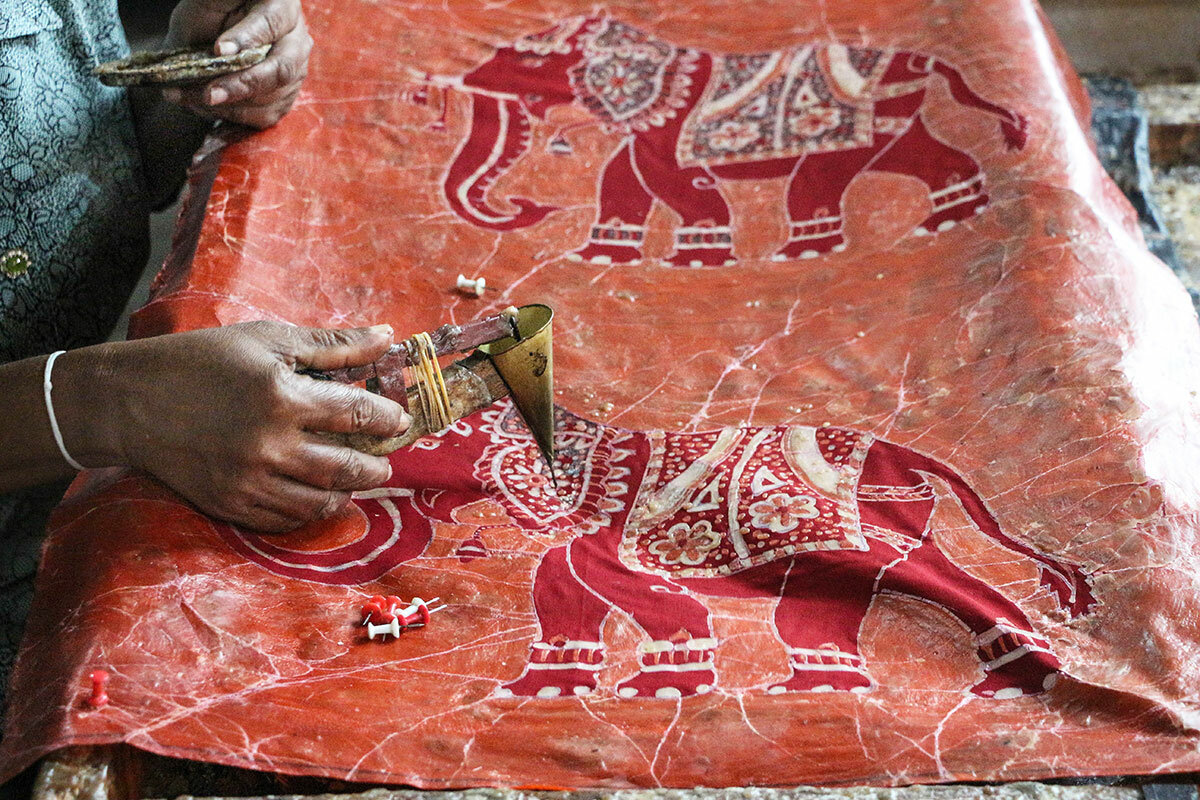Endurance test: How Sri Lanka’s batik artists keep the craft alive
Loading...
| Matara, Sri Lanka
Jezima Mohammed has run a small workshop and boutique, Jez Look Batiks, from her home in Matara, Sri Lanka, for nearly seven decades. Now in her 80s, she still works every day. When visitors stop by, the batik artist proudly shows off framed letters from Buckingham Palace and a photo of Queen Elizabeth II sporting a white satin scarf with baby pink florals – one of her designs. Meanwhile, outside, a group of artisans meticulously outline peacock motifs onto off-white fabric with boiling hot wax.
“They are my girls,” she says of the 16 women currently employed by her shop, “and we work like a family.”
It’s often said that batik came to Sri Lanka from Indonesia, where the art form is recognized by UNESCO as an important part of humanity’s intangible heritage, but late researcher Gerret Pieter Rouffaer believed it was India or Sri Lanka that introduced the resist dyeing technique to the Indonesian islands. Murky origins aside, batik flourished in Sri Lanka during the 1960s, with female artists like Ena de Silva creating massive tapestries that adorned the ceilings of Colombo’s most iconic buildings. Small businesses such as Ms. Mohammed’s shop emerged to meet the demand for the popular medium. Then, in 1983, civil war brought the industry to an abrupt halt.
Why We Wrote This
A story focused onKeeping a traditional craft alive in modern times often requires creativity and perseverance. Sri Lanka’s loyal batik artisans have both.
It never fully recovered, say artists and historians. Today, lingering impacts of pandemic lockdowns and record-high inflation make it difficult for cottage artisans to afford supplies, while waning interest in batik apprenticeship threatens the beleaguered art form’s future. Still, batik continues to endure thanks to passionate artists across the island. In fact, industry veterans such Ms. Mohammed say that decades of war and other hardships have helped prepare them for modern challenges.
“One thing is certain,” she says. “You have to keep going. You can’t stop your work. If you do, batik will stop.”
Careers defined by perseverance
Before the Sri Lankan Civil War, Ms. Mohammed’s workshop brimmed with curious outsiders wanting to learn about batik. “One traveler who came here mentioned me in an old guidebook, so everyday there was someone. Tourists loved it,” Ms. Mohammed says.
Making a batik garment starts with drawing the design on paper and planning out each color. Using a copper stylus and a mix of hot paraffin and beeswax, an artisan then outlines the pattern onto both sides of a natural, white fabric, which is then immersed in dye, starting with the lightest color. After the pigment sinks in, the artist can remove the wax with boiling water and move onto the next element of the design, repeating this process of waxing, dyeing, and boiling until the pattern is complete. The finished cloth is washed with soap and sun-dried before it’s sewn into kimonos or other garments. Ms. Mohammed also designed bedding, curtains, and staff uniforms for popular seaside hotels.
“It was a very bright, happy time,” she says. “Then the war started.”
As long standing ethnoreligious tensions erupted into violence across the island, those curious outsiders dwindled, but thanks to her now-international reputation for popular, fashionable garments, Ms. Mohammed was able to maintain a niche market for her designs. Former visitors and hotel owners continued to order new prints, and she was also invited to overseas workshops and exhibitions.
Still, times were tough, and she often found herself relying on the generosity of others.
“I met many kindhearted people who helped me a lot. When business was slow, my sons gave me small loans to pay my girls,” Ms. Mohammed says.
During lockdowns, she bore that lesson of community in mind, allowing her fellow artisans to work whenever they could and making sure they always had dry rations. “We are a team, and we have to look after each other,” Ms. Mohammed says.
Nowadays, Sri Lanka’s cost-of-living crisis makes it difficult to afford kerosene oil, Ms. Mohammed says. She goes out daily to buy dried coconut shells as an alternative fuel for her artisans’ wax burners.
It’s a devotion shared by other batik veterans, such as Gnana Prabha Ranasinghe, who resides in the southern city Galle and is one of Sri Lanka’s few male batik designers. Like many Sri Lankan crafts, batik is widely seen as a job for women, but Mr. Ranasinghe was eager to inherit his family’s home-based workshop in the 1970s.
Like Ms. Mohammed, he persevered through war and the pandemic, and now faces challenges related to Sri Lanka’s financial mismanagement and waning interest in the art form. Mr. Ranasinghe had 40 students in the 1990s, but only eight remain today, all women.
His family and friends have often suggested he close up his workshop, but Mr. Ranasinghe carries a sense of loyalty to this craft that he learnt from his father. Batik binds together the Ranasinghe generations, he says, and “I never thought of doing anything else, not even on days there was no business.”
Industry shifts
Both Mr. Ranasinghe and Ms. Mohammed worry that their beloved batik craft may be dying, as many youth shy away from the tradition.
“Young people find it slow,” he says. “They don’t like it. They like quick computer work in a comfortable office where they can dress in ironed, polished clothes.”
It’s true that the process is laborious, time-consuming, and messy. Boiling wax dribbles all over and bright dyes stain finger tips. Many artisans spend hours on a single design, whether they’re carefully tracing small dotted textures or manipulating fabric to create free-flowing patterns. No two pieces are the same.
“People ask if I can make 20 copies of one design. I can’t. It’s original and there’ll only be one like that,” says Ms. Mohammed. But some commercial factories can get fairly close. Artists there mass-produce as many as 20 textiles a day, using a single, simplified pattern and only one or two colors of dye. Ms. Mohammed says these cheaper batiks, though often lacking in quality, are edging traditional artists out of the marketplace.
But while young artists aren’t flocking to apprentice at their workshops and batik factories, Ms. Mohammed and Mr. Ranasinghe are grateful to a new generation of upmarket fashion designers who seem to be taking an interest in their craft.
This includes Nithya Lamhewa, whose street-style batik designs were featured at last year’s Mercedes-Benz Fashion Week in Colombo. When Ms. Lamhewa started her clothing brand Nithyarn 10 years ago, there were several internationally renowned batik brands in the capital, but they didn’t appeal to Sri Lanka’s young shoppers.
“Most batik designs we had were loose-fitting, boxy silhouettes or traditional garments like saris and kurta tops. Making batik is expensive so artists didn’t want to cut out fabric to make body-fitting garments, which would waste the fabric,” says Ms. Lamhewa, who set out to add a twist to traditional batik wear.
She came up with trendy sarongs, shirt dresses, and bomber jackets with graphic batik prints inspired by endemic animals and urban life. One striped shirt dress, from her 2017 collection, featured tricolor graphic batik of tuk-tuks. She shares her rule-breaking designs with thousands of followers on social media, helping introduce Sri Lankan batik art to a new generation.
“If we are to preserve the art form and champion it, we have to merge cottage batik industries with contemporary designs,” says Ms. Lamhewa.








